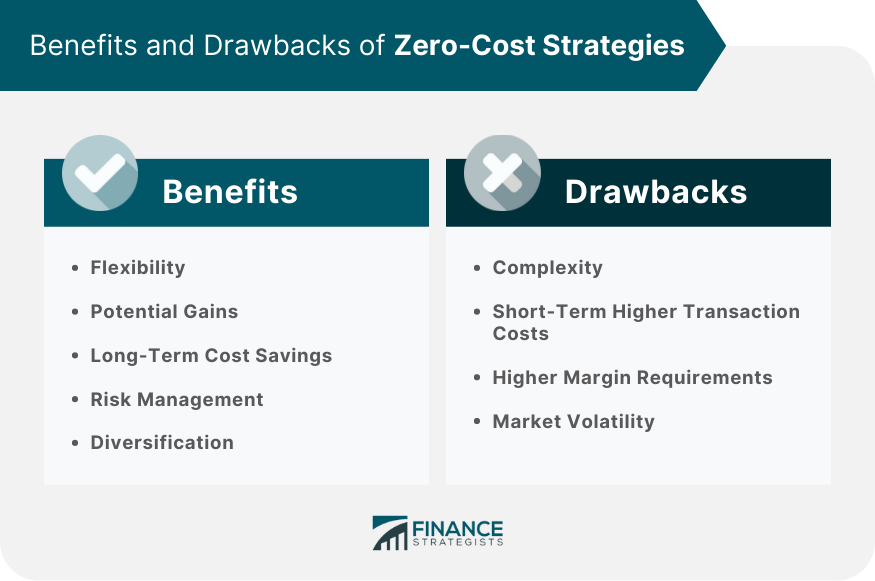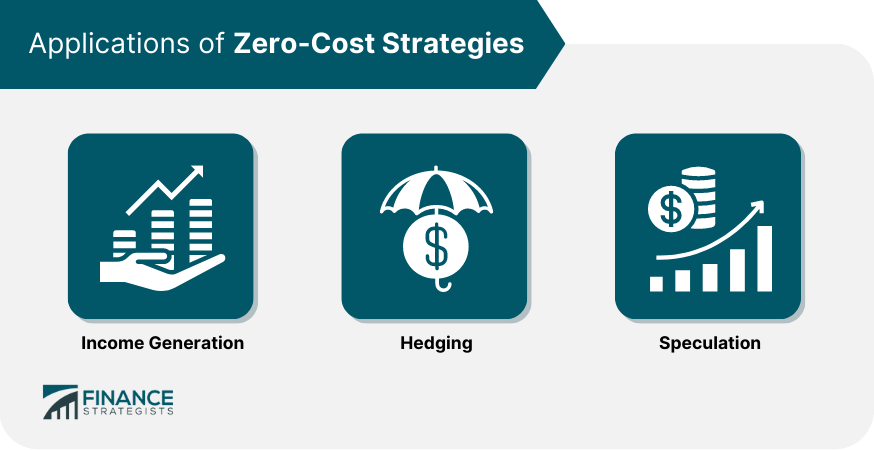A zero-cost strategy refers to a financial strategy that involves the creation of a portfolio with no upfront costs. This strategy is achieved by using financial instruments such as options, stocks, and bonds to offset the costs of other investments. In other words, a zero-cost strategy involves taking opposite positions in the financial markets to offset the costs of one another. The principle behind zero-cost strategies is to create a portfolio that requires no upfront costs while still maintaining the potential for gains. This is achieved by taking opposite positions in the financial markets to offset the costs of one another. For instance, a trader can use options to create a synthetic stock position with no upfront costs. The trader can then use this position to hedge against potential losses in the stock market while still maintaining the potential for gains. A zero-cost collar strategy involves buying a put option with a strike price below the current stock price and selling a call option with a strike price above the current stock price. This creates a range within which the stock price can fluctuate without affecting the overall value of the portfolio. The goal of this strategy is to protect the portfolio from potential losses while still maintaining the potential for gains. This strategy involves using options to create a synthetic long or short stock position with no upfront costs. This strategy is achieved by buying a call option and selling a put option with the same strike price and expiration date. This creates a synthetic long position with no upfront costs. Alternatively, a trader can buy a put option and sell a call option with the same strike price and expiration date. This creates a synthetic short position with no upfront costs. It involves selling a call option with a higher strike price and buying a call option with a lower strike price. The premium received from the call option sold offsets the cost of the call option bought. This strategy is used to generate income from the premium received while still maintaining the potential for gains. A zero-cost butterfly spread involves buying a call option with a lower strike price, selling two call options with a higher strike price, and buying a call option with an even higher strike price. This creates a range within which the stock price can fluctuate without affecting the overall value of the portfolio. The goal of this strategy is to generate income from the premium received while still maintaining the potential for gains. A zero-cost ratio spread involves buying a call option and selling a certain number of call options with a higher strike price. The premium received from the call options sold offsets the cost of the call option bought. This strategy is used to generate income from the premium received while still maintaining the potential for gains. A zero-cost strategy provides investors with flexibility in managing their investments. This approach allows investors to create a portfolio that requires no upfront costs while still maintaining the potential for gains. It also provides investors with the ability to adjust their portfolios as needed. By using financial instruments such as options, stocks, and bonds, investors can create a portfolio that maintains the potential for gains while minimizing costs. A zero-cost strategy can help investors save on costs. This approach allows investors to create a portfolio that requires no upfront costs, which can result in significant cost savings over time. Zero-cost strategies can help investors manage risks. By taking opposite positions in the financial markets to offset the costs of one another, investors can hedge against potential losses in the market while still maintaining the potential for gains. By using various financial instruments, investors can create a portfolio that is diversified and spread across different assets, which can help mitigate risks. Zero-cost strategies can be complex and require a deep understanding of financial markets and instruments. This complexity can lead to mistakes and potential losses. While a zero-cost strategy can save costs in the long run, it can result in higher transaction costs in the short term. This is because this approach involves taking opposite positions in the financial markets, which can result in more frequent transactions. Zero-cost strategies may require higher margin requirements. This is because the use of options and other financial instruments may require higher levels of collateral to cover potential losses. Zero-cost strategies may be impacted by market volatility. This is because the value of financial instruments used in this approach may fluctuate rapidly, which can result in potential losses. One of the main applications of zero-cost strategy is income generation. For instance, a trader can use a zero-cost credit spread to generate income from the premium received while still maintaining the potential for gains. Hedging involves using financial instruments to protect against potential losses in the market. For instance, a trader can use a zero-cost collar strategy to protect against potential losses in the stock market while maintaining the potential for gains. It involves taking positions in the market to profit from price movements. For instance, a trader can use a zero-cost synthetic stock position to take a long position in the stock market without incurring upfront costs. Zero-cost strategies are an important approach that individuals can use to manage their investments effectively. It is a useful tool for investors to generate income and manage risks, while minimizing costs. This strategy involves the use of various financial instruments such as options, stocks, and bonds to create a portfolio that does not require upfront costs. The benefits of this approach include flexibility, long-term cost-savings, and risk management. It is important to note that zero-cost strategies come with their own risks, such as complexity, higher short-term transaction costs, higher margin requirements, and market volatility. Nonetheless, investors can mitigate these risks by doing their due diligence, using proper risk management techniques, and staying up-to-date on market trends and news. With advancements in technology and the increasing popularity of options trading, the use of zero-cost strategies is expected to continue to grow in the future.What Is a Zero-Cost Strategy?
Types of Zero-Cost Strategies
Zero-Cost Collar Strategy
Zero-Cost Synthetic Stock Position
Zero-Cost Credit Spread
Zero-Cost Butterfly Spread
Zero-Cost Ratio Spread
Benefits of Zero-Cost Strategies
Flexibility
Potential Gains
Long-Term Cost Savings
Risk Management
Diversification
Drawbacks of Zero-Cost Strategies
Complexity
Short-Term Higher Transaction Costs
Higher Margin Requirements
Market Volatility

Applications of Zero-Cost Strategies
Income Generation
Hedging
Speculation

Final Thoughts
Zero-Cost Strategy FAQs
A Zero-Cost Strategy is an investment technique where an investor acquires an asset, such as a stock, and simultaneously sells options to offset the cost of the asset.
In a Zero-Cost Strategy, the investor purchases an asset and simultaneously sells call options at a strike price that is equal to or greater than the purchase price of the asset. This generates an option premium that offsets the cost of the asset.
The primary benefit of a Zero-Cost Strategy is that it enables an investor to acquire an asset without incurring any upfront costs. It can also be used to generate income, reduce risk, and enhance portfolio returns.
One of the main risks associated with a Zero-Cost Strategy is that if the price of the underlying asset declines, the investor may suffer losses. Additionally, if the price of the asset rises above the strike price of the call option, the investor may miss out on additional gains.
Zero-Cost Strategies can be useful for investors who want to acquire an asset without incurring any upfront costs or who want to generate additional income from their portfolio. However, they require a certain level of knowledge and expertise, and may not be suitable for all investors.
True Tamplin is a published author, public speaker, CEO of UpDigital, and founder of Finance Strategists.
True is a Certified Educator in Personal Finance (CEPF®), author of The Handy Financial Ratios Guide, a member of the Society for Advancing Business Editing and Writing, contributes to his financial education site, Finance Strategists, and has spoken to various financial communities such as the CFA Institute, as well as university students like his Alma mater, Biola University, where he received a bachelor of science in business and data analytics.
To learn more about True, visit his personal website or view his author profiles on Amazon, Nasdaq and Forbes.











